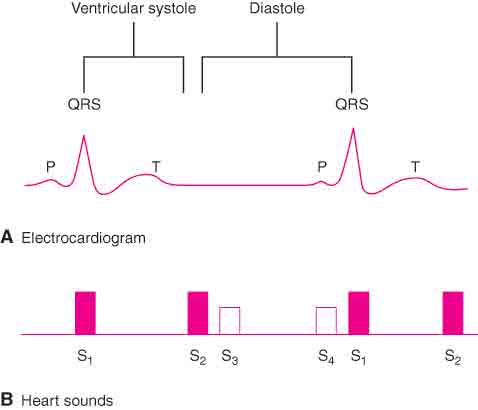| During auscultation, the first heart sound, S1, is heard as the “lub” of “lub-dub.” This sound occurs when the mitral and tricuspid valves close, and it corresponds to the onset of ventricular contraction. The sound, low-pitched and dull, is heard best at the apical area. The second heart sound, S2, occurs at the termination of systole and corresponds to the onset of ventricular diastole. The “dub” of “lub-dub,” it represents the closure of the aortic and pulmonic valves. The sound of S2 is higher-pitched and shorter than S1. The two sounds occur within 1 second or less, depending on the heart rate. Normal findings include S1 that is louder at the tricuspid and apical areas, with S2 louder at the aortic and pulmonic areas.

Heart sounds in relation to the cardiac cycle and an electrocardiogram. | Abnormal findings include extra heart sounds at any of the cardiac landmarks and abnormal rate or rhythm. A wide variety of conditions may alter the normal heart rate or rhythm, including serious infections, anemia, diseases of the heart muscle or conducting system, dehydration or overhydration, endocrine disorders, respiratory disorders, and head trauma. Extra heart sounds may be S3, S4, or murmurs.
- S3, known as the third heart sound, follows S2, and is often represented by a “lub-dub-dee” pattern (“dee” being S3). This sound is best heard with the stethoscope bell at the mitral area, with the patient lying on the left side. S3 is considered normal in children and young adults and abnormal in middle-aged and older adults.
- S4 is the fourth heart sound, occurring right before S1, and is often represented by a “dee-lub-dub” pattern (“dee” being S4). S4 is considered normal in older adults but abnormal in children and adults.
- Heart murmurs are extra heart sounds caused by some disruption of blood flow through the heart. The characteristics of a murmur and grading depend on the adequacy of valve function, rate of blood flow, and size of the valve opening. Usually, nurses are more concerned with recognizing changes in murmurs rather than in diagnosing and labeling them (Jensen, 2019, p. 467). Refer to information on a health assessment text for grading details and additional information related to assessment of heart sounds.
|
